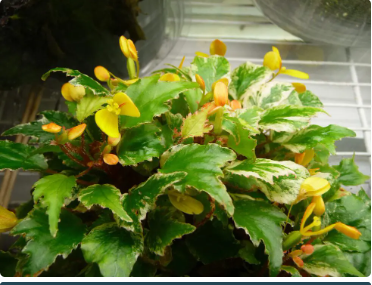Begonias are some of the most beloved ornamental plants, known for their striking foliage and vibrant flowers. Whether you’re a seasoned gardener or just starting your journey into plant care, begonias offer a world of beauty and variety that can easily transform any space into a colorful sanctuary. In this comprehensive guide, we will explore everything about begonias—from understanding the different varieties to mastering the art of begonia care. By the end of this article, you’ll be well-equipped to grow healthy, thriving begonias in your home or garden.
Introduction to Begonias

Begonias are a diverse genus of perennial plants that belong to the Begoniaceae family. Native to tropical and subtropical regions, they are adored for their unique combination of showy flowers and dramatic foliage. With more than 1,800 species and countless hybrids, begonias come in a wide range of shapes, sizes, and colors. Their adaptability to both indoor and outdoor environments makes them a favorite among plant enthusiasts.
The popularity of begonias lies not only in their aesthetic appeal but also in their ease of care. These plants can thrive with minimal maintenance, provided their basic needs are met. Let’s dive deeper into the fascinating world of begonias and discover how you can bring these captivating plants into your home or garden.
Types of Begonias
The vast variety of begonias can be categorized into three main groups: fibrous-rooted, rhizomatous, and tuberous begonias. Each type has its own unique characteristics, making them suitable for different environments and purposes.
Fibrous-Rooted Begonias
Fibrous-rooted begonias are known for their thin, fibrous root systems. These plants are versatile and come in two primary subcategories: wax begonias and cane begonias.
- Wax Begonias: These are popular bedding plants, often found in gardens due to their resilience and ability to bloom all year round. Their waxy leaves and small clusters of flowers in shades of white, pink, and red make them ideal for adding a splash of color to any space.
- Cane Begonias: Cane begonias, often referred to as “angel wing begonias” due to the shape of their leaves, are prized for their tall, upright stems and lush, cascading foliage. They are often grown indoors as houseplants.
Rhizomatous Begonias
Rhizomatous begonias are characterized by their thick, creeping stems known as rhizomes, which grow horizontally. These begonias are primarily grown for their striking foliage rather than their flowers.
- Rex Begonias: Perhaps the most well-known rhizomatous begonia, the Rex begonia is famous for its multicolored, often metallic-looking leaves. With shades of silver, purple, red, and green, Rex begonias are the ultimate statement plant for any home or office.
Tuberous Begonias
Tuberous begonias produce large, showy blooms that resemble roses or camellias. These begonias are perfect for container gardening and hanging baskets due to their trailing growth habits. They are commonly grown outdoors, but can also be brought indoors during the colder months.
- Begonia Boliviensis: Known for their vibrant, fiery flowers, Begonia boliviensis is a popular choice for outdoor gardens, adding a tropical feel to shaded areas.
Begonia Care: How to Keep Your Plants Thriving
Despite their stunning appearance, are relatively easy to care for, as long as you provide them with the right conditions. Below are the key elements to ensure your flourish.
Light Requirements
thrive in bright, indirect light. Too much direct sunlight can scorch their delicate leaves, especially in the case of Rex and other foliage varieties. Tuberous prefer partial shade and will do well in a spot that receives morning sun and afternoon shade. For indoor , placing them near an east or west-facing window is ideal.
Watering
prefer to be kept evenly moist, but not waterlogged. Overwatering is a common cause of root rot, so it’s essential to let the soil dry out slightly between waterings. When watering, focus on the soil rather than the leaves, as wet foliage can lead to fungal diseases. During winter, reduce watering, especially for tuberous varieties, as they enter a period of dormancy.
Soil and Fertilization
The ideal soil for is a well-draining, rich potting mix. Adding perlite or peat moss to your soil mix can improve drainage and prevent the roots from becoming waterlogged. Fertilize your every two to four weeks during the growing season with a balanced, water-soluble fertilizer. For foliage varieties like Rex , you can use a fertilizer higher in nitrogen to promote lush, vibrant leaves.
Humidity and Temperature
thrive in environments with moderate to high humidity. If you’re growing them indoors, consider placing a humidity tray or using a humidifier to maintain moisture levels around your plants. prefer temperatures between 65°F and 75°F. They are sensitive to cold drafts and should be kept away from windows or doors that may expose them to chilly air.
Common Begonia Problems and Solutions
While are generally low-maintenance plants, they can occasionally encounter problems. Below are some common issues and how to address them:
Yellowing Leaves
Yellowing leaves can be a sign of overwatering or poor drainage. Ensure that your are planted in well-draining soil and that you’re allowing the top layer of soil to dry out before watering again.
Powdery Mildew
Powdery mildew is a fungal disease that can affect , especially in humid environments. It appears as a white, powdery substance on the leaves. To prevent powdery mildew, ensure good air circulation around your plants and avoid wetting the foliage when watering.
Root Rot
Root rot occurs when the roots of the plant are left in soggy soil for too long. To prevent this, always use well-draining soil and avoid overwatering. If you notice black, mushy roots, it’s best to remove the affected areas and repot the plant in fresh soil.
Propagating Begonias: Multiply Your Collection
One of the joys of growing is how easy they are to propagate. Whether you’re looking to expand your collection or share your plants with friends, propagating is a rewarding experience. There are several methods of propagation, depending on the type of begonia you’re working with.
Stem Cuttings
Stem cuttings are a common method of propagating cane . Simply cut a healthy stem with at least two nodes and place it in water or moist soil. Within a few weeks, the cutting will develop roots and can be transplanted into its own pot.
Leaf Cuttings
Rex and other foliage varieties can be propagated through leaf cuttings. Take a healthy leaf and cut it into sections, ensuring each section has a part of the main vein. Place the sections on moist soil, and in a few weeks, new plants will start to emerge.
FAQs
What is the best type of begonia for beginners?
Wax begonias are an excellent choice for beginners due to their hardiness and low-maintenance nature.
Can begonias grow indoors?
Yes, many , especially Rex and cane , thrive indoors as houseplants.
Do begonias need a lot of sunlight?
prefer bright, indirect light. Too much direct sunlight can burn their leaves, especially for foliage varieties.
How often should I water my begonia?
Water your begonia when the top inch of soil feels dry. Be careful not to overwater, as are susceptible to root rot.
Can I propagate begonias from a single leaf?
Yes, certain , like Rex begonias, can be propagated through leaf cuttings.
What is the best soil for begonias?
Begonias thrive in well-draining soil, such as a potting mix with added perlite or peat moss for improved drainage.
Conclusion
Begonias are truly versatile plants that can bring life and color to any space, whether indoors or outdoors. With their stunning foliage and vibrant blooms, have earned their place as one of the most popular ornamental plants. By following the care tips and propagation methods outlined in this guide, you can enjoy a flourishing begonia collection for years to come.








